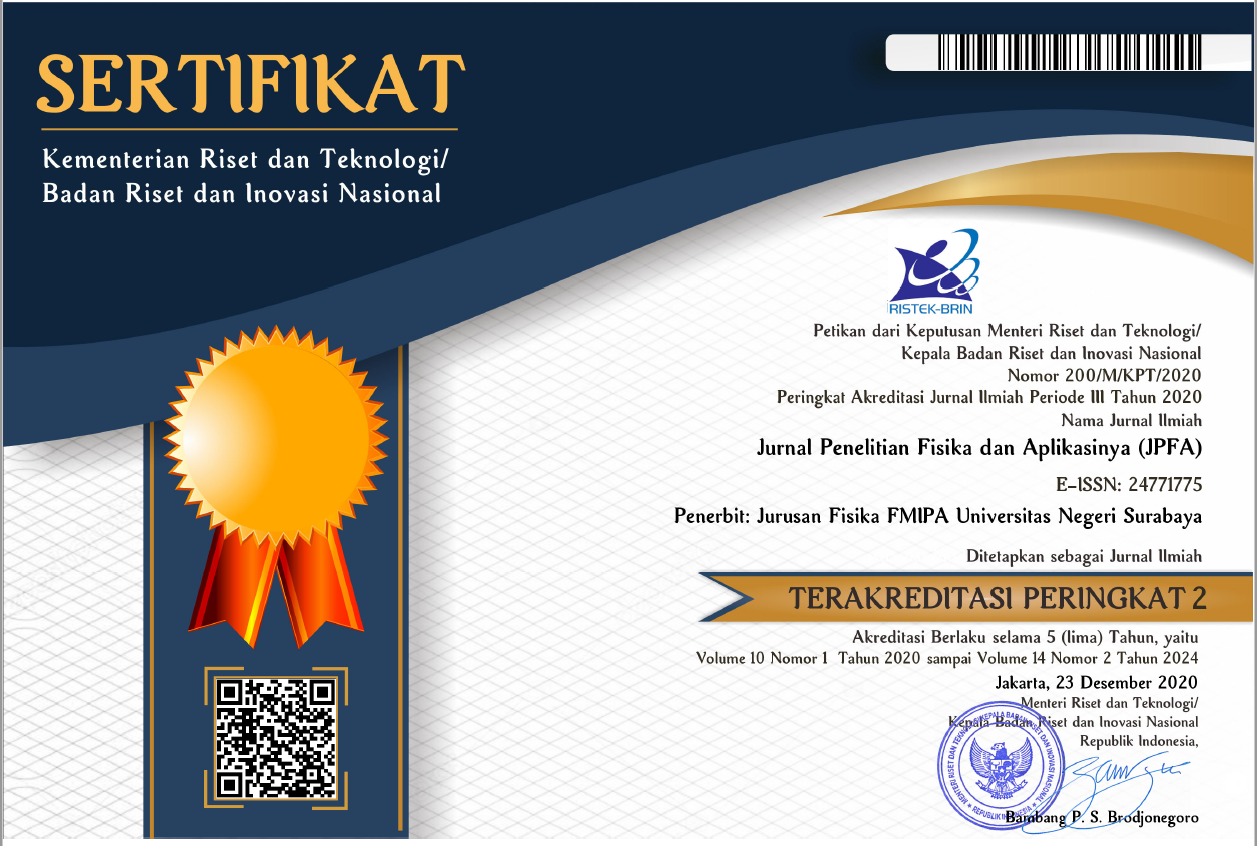PENGARUH PERUBAHAN INTENSITAS CAHAYA HALOGEN RUTHENIUM (N719) FOTOSENSITIZER DALAM DYE-SENSITIZED SOLAR CELL(DSSC)
DOI:
https://doi.org/10.26740/jpfa.v6n2.p70-76Keywords:
Dye-Sensitized Solar Cell (DSSC), fotosensitizer, N719, absorbansi, konduktivitasAbstract
Penelitian ini merupakan penelitian awal untuk mempelajari dan memahami proses pembuatan sel surya berbasis Dye Sensitized Solar Cell (DSSC) menggunakan Ruthenium (N719). Lapisan fotoelektroda TiO2 menggunakan pasta TiO2 ukuran 21 nm yang dideposisi menggunakan teknik spin coating dan pewarna N719 sebagai dye sensitizer. Counter elektroda Platina dideposisi menggunakan teknik sputtering. Parameter proses yang mempengaruhi karakteristik listrik sel surya dianalisa dan diukur. Karakteristik kurva I-V sel surya diukur menggunakan Kethely dengan variasi intensitas yaitu 100 Watt/m2, 250 Watt/m2, 500 Watt/m2, 750 Watt/m2 dan 1000 Watt/m2.Prototipe sel yang terbaik menghasilkan effisiensi sebesar 0,15%.Uji absorbansi menggunakan Spectrophotometer UV Visible 1601 PC dan uji sifat kelistrikan menggunakan Elkahfi 100/Meter I-V. Hasil menunjukkan bahwa pewarna organik sintesis ruthenium (N719) memiliki absorbansi yang kuat pada panjang gelombang 400-550 nm ini menjadikan dye ruthenium (N719) perlu untuk di selidiki sebagai bahan fotosensitizer DSSC.
References
Reagen BO dan Gratzel M. A Low-Cost, High-Efficiency Solar Cell Based on Dye-Sensitized Colloidal Ti0(2) Films. Nature. 1991; 353(6346): 737-740. DOI: http://dx.doi.org/10.1038/353737a0
Ito S, et al. Photovoltaic characterization of dye-sensitized solar cells: Effect of device masking on conversion efficiency. Prog. Photovoltaics Res. Appl. 2006; 14(7): 589-601. DOI: http://dx.doi.org/10.1002/pip.683
YM Xiao, et al. Low temperature fabrication of high performance and transparent Pt counter electrodes for use in flexible dye-sensitized solar cells. Chinese Sci. Bull. 2012; 57(18): 23292334. DOI: https://doi.org/10.1007/s11434-012-5110-6
Hagfeldt A, et al. Verification of high efficiencies for the gratzel-cell - a 7-percent efficient solar-cell based on dye-sensitized colloidal TiO2 films. Sol. Energy Mater. Sol. Cells. 1994; 31(4): 481488.
Ma T, Akiyama M, Abe E, dan Imai I. High-efficiency dye-sensitized solar cell based on a nitrogen-doped nanostructured titania electrode. Nano Lett. 2005; 5(12): 2543-2547. DOI: https://doi.org/10.1021/nl051885l
TH Meen, et al. Applications of vertically oriented TiO2 micro-pillars array on the electrode of dye-sensitized solar cell. J. Phys. Chem. Solids. 2011; 72(6): 653656. DOI: https://doi.org/10.1016/j.jpcs.2011.02.008
Kalyanasundaram K dan Gratzel M. Applications of functionalized transition metal complexes in photonic and optoelectronic devices. Coord. Chem. Rev. 1998; 177(1): 347414. DOI: https://doi.org/10.1016/S0010-8545(98)00189-1
Purwanto A, Widiyandari H, dan Jumari A. Fabrication of high-performance fluorine doped-tin oxide film using flame-assisted spray deposition. Thin Solid Films. 2012; 520(6): 20922095. DOI: https://doi.org/10.1016/j.tsf.2011.08.041
Agarwala S, et al. Mesophase ordering of TiO2 film with high surface area and strong light harvesting for dye-sensitized solar cell. ACS Appl. Mater. Interfaces. 2010; 2(7): 18441850. DOI: https://doi.org/10.1021/am100421e
Downloads
Published
How to Cite
Issue
Section
License
Author(s) who wish to publish with this journal should agree to the following terms:
- Author(s) retain copyright and grant the journal right of first publication with the work simultaneously licensed under a Creative Commons Attribution-Non Commercial 4.0 License (CC BY-NC) that allows others to share the work with an acknowledgement of the work's authorship and initial publication in this journal for noncommercial purposes.
- Author(s) are able to enter into separate, additional contractual arrangements for the non-exclusive distribution of the journal's published version of the work (e.g., post it to an institutional repository or publish it in a book), with an acknowledgement of its initial publication in this journal.
The publisher publish and distribute the Article with the copyright notice to the JPFA with the article license CC-BY-NC 4.0.
 Abstract views: 1811
,
Abstract views: 1811
, PDF Downloads: 1482
PDF Downloads: 1482









